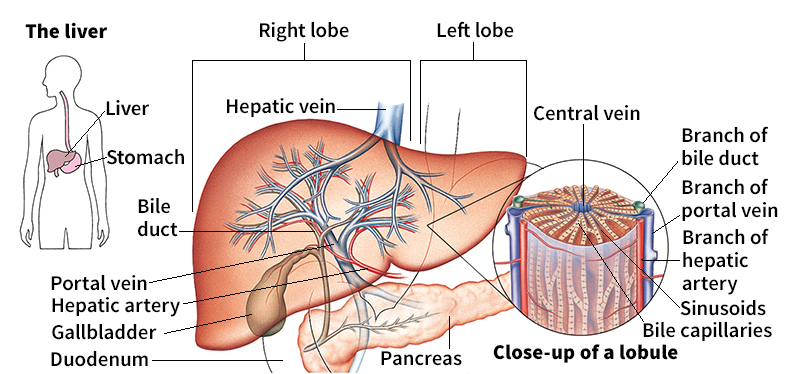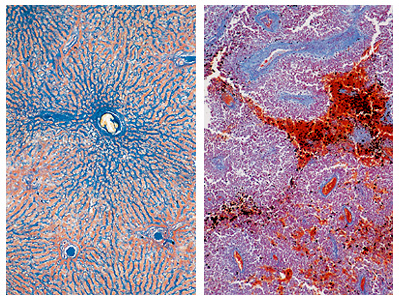Liver is the largest gland in the human body and one of the most complex of all human organs. It serves as the body’s main chemical factory and is one of its major storehouses of energy. The liver is a reddish-brown mass weighing about 3 pounds (1.4 kilograms). It sits in the upper right part of the abdomen, under the diaphragm and above the stomach and intestines.

The liver performs many essential functions. One of its most important tasks is to help the body digest food. The liver produces and discharges bile, a greenish-yellow digestive fluid. Bile travels from the liver to the small intestine, where it aids in the digestion of fats. Extra bile is stored in the gallbladder, a pear-shaped pouch that lies under the liver.
The liver also stores energy from food. Digested food travels in the blood from the small intestine to the liver. The liver removes some of the digested food from the blood and converts it into stored energy. This energy can be released to fuel the functions of the body. The liver also converts some digested food into compounds needed by the body’s cells.
The liver also filters poisons and wastes from the blood. Some substances produced by the liver help the body to fight disease. Others enable the blood to clot.
The liver has a remarkable ability to produce new cells to replace its own diseased or damaged cells. For example, surgeons can remove a section of a healthy liver from an adult and transplant it into a child who has a diseased liver. The adult’s liver will rapidly regenerate and be restored to full size. The child’s new liver will grow as the child grows.
Structure of the liver
The liver consists of four sections, or lobes. There are two main lobes—the right lobe, which is by far the larger, and the left lobe. Two small lobes lie behind the right lobe. Each lobe is made up of multisided units called lobules. Most livers have between 50,000 and 100,000 lobules. Each lobule consists of a central vein surrounded by tiny liver cells grouped in sheets or bundles. These cells perform the work of the liver. Cavities known as sinusoids separate the groups of cells within a lobule. The sinusoids give the liver a spongy texture and enable it to hold large amounts of blood.
The liver has an unusual blood supply. Like other organs, the liver receives blood containing oxygen from the heart. This blood enters the liver through the hepatic artery. The liver also receives blood filled with nutrients from the small intestine. This blood enters the liver through the portal vein. In the liver, the hepatic artery and the portal vein branch into a network of tiny blood vessels that empty into the sinusoids.
The liver cells absorb nutrients and oxygen from the blood as it flows through the sinusoids. They also filter out wastes and poisons. At the same time, they secrete minerals, sugar, vitamins, and other substances into the blood. The sinusoids drain into the central veins, which join to form the hepatic vein. Blood leaves the liver through the hepatic vein, which drains to the heart.
Each lobule also contains bile ducts, tiny tubes that carry the bile secreted by the liver cells out of the liver. The bile capillaries join to form bile ducts, which carry bile out of the liver. Soon after leaving the liver, the bile ducts join together, forming the hepatic duct. The liver manufactures bile continuously. Excess bile flows into the gallbladder, where it is stored for later use. Bile from the liver and gallbladder flows into the small intestine through the common bile duct.
Functions of the liver
The liver has two chief functions. They are: (1) to help the body digest and use food and (2) to help purify the blood of wastes and poisons.
Digestion and use of food.
The secretion of bile ranks as one of the liver’s most important functions. Bile consists of bile salts and several other substances. The bile salts act on fats in the small intestine. They reduce the size of fat droplets, helping enzymes in the intestine to convert fat molecules into fatty acids (a kind of organic acid) and into an alcohol called glycerol.
The liver also regulates the amount of certain nutrients that the cells of the body receive. Digestive enzymes in the intestine break down proteins into amino acids and carbohydrates into simple sugars, primarily glucose. The blood carries these nutrients—as well as vitamins, minerals, and fatty acids and glycerol—to the liver. The liver removes the excess glucose from the blood and stores it in the form of a starchlike compound called glycogen. Glucose serves as the chief fuel for the body’s cells. When the body needs energy, the liver converts glycogen to glucose and releases it into the blood. The liver also converts fatty acids and amino acids into glucose when its store of glycogen is low. In this way, the liver helps ensure that the cells of the body receive a constant supply of fuel.
The liver also plays an essential role in the storage of certain vitamins. The liver stores vitamin A, as well as vitamins D, E, and K, and those of the B-complex group. It also stores iron and other minerals.
Purification of the blood.
Liver cells filter harmful substances from the blood. Such substances include drugs, food additives, and industrial chemicals. Enzymes in the liver cells convert some of these substances into products that dissolve in water. The blood then transports the substances to the kidneys, which discharge them in urine. Other harmful substances are excreted in the bile. The liver also filters many bacteria, viruses, and other microorganisms from the blood.
In addition, the liver filters out waste substances produced by the body. When red blood cells die, they release hemoglobin, the compound that enables them to carry oxygen. Cells in the liver and other organs break down hemoglobin into several substances, including iron and a reddish-yellow pigment called bilirubin. The liver discharges bilirubin in bile. It stores iron for use in producing new red blood cells. The liver also rids the body of ammonia, a poisonous waste formed when amino acids are changed to other compounds in the liver. The liver converts the ammonia to urea, which is eventually discharged in urine.
Other functions.
The liver manufactures various blood proteins, including albumin, globulins, and fibrinogen. Albumin helps to prevent plasma (the liquid portion of the blood) from seeping through the walls of the blood vessels. Globulins help the body fight infections. Fibrinogen enables the blood to seal broken blood vessels by forming a clot.
The liver also secretes cholesterol, a fatty substance. The body uses cholesterol to build cell membranes and to manufacture certain hormones, including the sex hormones. Hormones are chemicals that influence various body functions. Liver cells use cholesterol to manufacture bile salts.
Diseases of the liver
Because the liver performs so many vital jobs, liver diseases can have serious consequences. Death occurs if the liver stops functioning. In some cases of advanced liver disease, physicians can perform a liver transplant. In this procedure, they remove a damaged liver and replace it with a healthy liver from a donor.
Most liver diseases are difficult to detect in the early stages. In many cases, one of the earliest signs of liver disease is jaundice. Jaundice occurs when the blood contains an excessive amount of bilirubin. This excess bilirubin causes a yellowish discoloration of the skin and the whites of the eyes. Jaundice may result if diseased liver cells fail to remove bilirubin from the blood. Jaundice also may occur if gallstones or scar tissue block the common bile duct, preventing the excretion of bilirubin in the bile. See Jaundice .

Hepatitis
is an inflammation of the liver. Hepatitis may be caused by viruses or by toxins. There are five main types of viral hepatitis, known by the letters A, B, C, D, and E. They are spread in different ways and have different characteristics. For example, hepatitis A usually spreads through food and water that have been contaminated by human or animal waste. Most cases do not result in serious illness. Hepatitis B is transmitted by close contact with an infected person or by exposure to infected blood. Severe cases of hepatitis B can lead to liver failure and death. Vaccines that prevents hepatitis A and B are available. Public health experts in the United States recommend that all children and certain high-risk adults be vaccinated against these diseases. Toxic hepatitis can result from exposure to various chemicals. Such substances include certain medications, such as the painkiller acetaminophen. See Hepatitis.
Cirrhosis
occurs when scar tissue replaces healthy liver cells. This process decreases the ability of the liver to perform its vital functions. Cirrhosis ranks as a leading cause of death in many countries. However, not all cases of cirrhosis result in death. Alcoholism is the most common cause of cirrhosis. Hepatitis can also cause cirrhosis. See Cirrhosis.
Other liver diseases.
The liver frequently becomes infected when diseases strike other parts of the body. Such diseases as amebic dysentery, histoplasmosis, syphilis, and tuberculosis—which begin elsewhere in the body—can eventually affect the liver. Cancers from other parts of the body also often spread to the liver.
